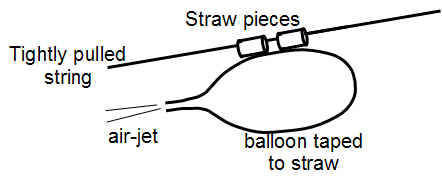Storytelling Science
Fire your own guided missile
Amitabha Mukerjee
All my life, science class meant lectures. All science labs were fraud, where we wrote down the numbers expected of us. In class eight however, we had a teacher called Mr. Das. He often rigged up something with all of us helping, right there in class. And then we would make a lot of noise playing with the setup. Naturally Mr. Das never got along with the principal - and to the best of our knowledge as students, he was actually asked to leave. It was much later that we realized what we had learnt from him, and how much this knowledge had stayed with us.
One of the most memorable lessons from Mr. Das was when he had us build guided missiles. Now, we are not talking about the Agni missile which can take a payload heavier than a Maruti car from Kashmir to Kanyakumarika in minutes. The Agni costs four crores and you couldn't build it in your classroom unless you were in deep cahoots with Al-Qaeda. What we did was to build a jet missile with fly-by-wire guidance (just like the Agni), using merely cheap balloons and strings, as well as some drinking straw, and scotch tape.

Inflate and Blast off!! First, you need to stretch a long string across a large space. Try to make the ties at each end fairly easy to open - this can be done by winding them four times around a nail. Next, you inflate the balloon and tie up the mouth. Then you cut a long tube from the drinking straw, scotchtape it to the balloon near the ends, and cut off the middle part. Put the string through the straw pieces, and open the mouth of the balloon: presto - your missile will sails across the room.
A missile game
Here is a noisy game you can play out of this. A number of teams build fly-by-wire missiles across the same space (e.g. a classroom), with half the team at each wall. All teams at the receiving end are given half of a secret message. The teams at the other end get the other half. First the launching team sends the empty missile across, and then the other team attaches their message and sends it back. The first team to complete the message wins. Winners will have to have experimented with first - what is the best degree of inflation, how much cellotape?You can make your missiles fly across some open space (you can finally send messages to the good-looking girl on the window across your street). For this, you will need to find a stone and safely throw the string across to the opposite window, preferably without breaking too much glass.
Why does it fly? There are several ways of looking at this. As you inflate the balloon, you pressurize the inside air - the more you inflate it, the higher this pressure. As this high-pressure air escapes backward, it pushes the air inside in the opposite direction (every action has an equal and opposite reaction, "Newton's Third law"). Finally, this air pushes the balloon forward.
A holistic approach looks at the whole balloon-air system. Initially it is not moving, so its momentum (mass times velocity), is zero. When the mouth is opened, the air jetting backward gets a negative momentum. To "conserve the total momentum", the rest of the balloon must move forward.
Finally, you can test the distance the balloon will travel as a function of the initial size, and estimate a function based on the drag of the shape moving through air (and the friction of the string); maybe you can even make some new scientific discovery!
